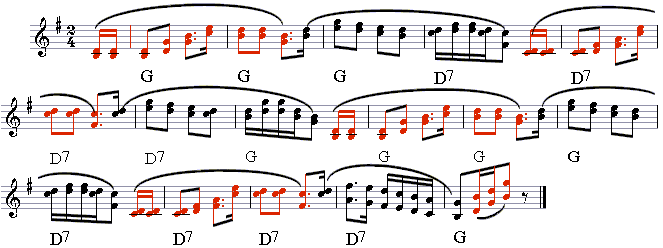Phrases
Phrases, in music these are small parts of the tune, which build up the melody. One can and should divide a melody into little phrases. I show this with the Gretlpolka:

In this way I would divide the melody into phrases. In every case two of these phases belong to each other, and build a larger phrase. After two of these larger phrases, the melody is in reality already complete, and starts from the beginning. This is called “Halbschluss”. (half cadence). The “Ganzschluss” (perfect cadence) on the end of the last (here black) phrase is with the main voice always on the 1st note of the scale, here in G major the G. Since the measure is in most cases too long (or the melody too short), an add-on “Nachsatz” (here coloured red) is added to bring the melody to is complete length. And this also ends with the 1st note of the scale.
By the way, the bows in the example have nothing in common with slurs or ties. If you, like me, would rather not bind the melody, skip it. I used these bows only for demonstration reasons. To build a thought bracket across the phrase.
So you see the phrases have nothing in common with the bars of the measures. Nothing with the melody and harmony, and in most cases, nothing with pauses. One could see some parallels to sentences in speaking, or better yet a question and answer conversation.
For an example, of what such a question-answer game could look like, I combine the melody (or every melody) with some more or less senseless text. For instance:
She:
Hey, what are we doing this evening, hey?
He: Come along with me, we’ll go to pub!
She: No, today I like to stay at home?
He: At the pub the musicians play today!
She: No, I don’t have anything to wear?
He: Come along, I’d really like to dance with you!
She: Well, I really like to dance with you.
He: I’ll buy you a dinner of “Rehragout”.
She: Juchu!
Give it a try, sing or hum some senseless and rhyme-less text, loud, quiet, just in your mind, and you will see, your melody, your performance wins big on swing and persuasive power.
By the way, it is not forbidden to sing along while playing, to yell the self-made text into the area. Quite the opposite, if you sing with self-confidence, you will charm the public with it much more than with a soft and pretty melody. In any case this does not call for a 4-voice harmony, instead, loud one or two voice singing that overcomes the loudness of the other instruments.
You can see which more or less senseless text came into my or someone else’s mind, many times on some of my note sheets, for instance Arnreiter Polka.
Most important: while performing one should not think of notes or single tones, one should think of the whole melody or at a minimum a complete phrase. Just as you don’t think about single letters when you are talking, you think about complete sentences and their context and coherence. Music is much more than the sum of its notes, just as a poem is much more than the sum of its letters.
These kinds of phrases, melodic statements, complete melodies should be divided, not joined to each other. Also within a phrase a legato is very seldom correct. In most cases it is better to play the notes (tones) short to broad, but always with a distinct separation from each other. This applies especially for the bass.
You can also try to express the individual phrases differently. For instance in the previous example the female part with shorter notes, and the male part with somewhat longer, jubilant notes. Or you start every phrase quietly, and get louder and toward the end of the phrase you take down the volume again, as the bows in the phrases above suggest. Or you play the female part with less volume, and the male part louder. Or you “jodel” the male part, along with the instrument. Or the female part is played with the Steirischen alone and on the male part all the instruments join in. Or …
Or you quickly forget the previous chapter again and play it all without any special emphasis, at least for some melodies. Sometimes it is enough just to think about some phrasing, this has to be tested with each and every melody.
Give it a try. Make a test.
![]()
[Deutsche Version]
